
There’s nothing luxurious about wasted space. You’ve curated every inch of your home, so why let your landscaping fall flat? A mismatched lawn and a few standard shrubs won’t cut it when your surroundings could be so much more. When your outdoor environment doesn’t match the lifestyle you’ve built inside, it’s a missed opportunity and a disconnect.
Luxury landscape design changes how your home lives and breathes. It’s not filler, it’s function, beauty, and identity working together in every square foot. Luxury landscape design creates outdoor environments that feel lived in, layered, and unmistakably yours. It invites you to experience your property fully, not just walk past it. If you live in the Atlanta area or its surrouding communities, you might be envisioning a luxury outdoor space that matches the elegance of your home.
If you’re not sure where to start, this guide is your blueprint. Built by industry leaders with decades of experience and designed to help you rethink the boundaries of your property so you can turn your landscape into a signature feature of your home.
The Foundations of Luxury Landscape Design

Luxury starts with intention. Every element in a high-end landscape should reflect how the space will be used and experienced. Laying this groundwork ensures your outdoor environment purposeful and intelligent, beautiful yet functional.
Blend Aesthetics & Function
True luxury landscape design is a balance of equal parts form and function. A well-executed outdoor environment should feel intentional, tailored not only to your home’s architecture but also to how you live. Every plant, pathway, and patio should serve a purpose, whether it’s guiding guests, offering privacy, or providing shade on hot Atlanta afternoons.
The key is planning with both beauty and usability in mind. You’re not just selecting plants, you’re shaping views, framing outdoor experiences to enhance how your space works day to day. When you strike the right balance, the result is seamless: a landscape that looks stunning and lives even better.
Personalize Your Outdoor Space
A high-end landscape should reflect you just as much as your interior design does. That starts with identifying what you want from your outdoor space and making design choices that support those goals.
Start with the feeling you want the space to give off, then let that guide your choices. A minimal, calming layout might call for structured plantings, soft neutrals, and clean hardscapes. A more expressive space could lean into bold shapes, contrasting textures, and vibrant colors. Every detail should support the mood you’re creating, and reflect how you actually want to spend time outdoors.
Innovative Features for Modern Living
Luxury works best when it’s intentional. In modern landscape design, that means combining refined aesthetics with smart, sustainable systems. Wi-Fi-enabled irrigation adjusts automatically to Atlanta’s shifting weather, while integrated lighting adapts to your routine. The right technology doesn’t complicate your outdoor space, it makes it efficient, functional, and easier to enjoy every day.
Smart systems cut down on maintenance demands and give you exact control over your outdoor environment. Pre-set lighting scenes can shift with the rhythm of the day, irrigation adapts instantly to changes in weather, and even your outdoor kitchen can operate in sync with the rest of your home’s systems.
Designing Luxury Outdoor Living Spaces
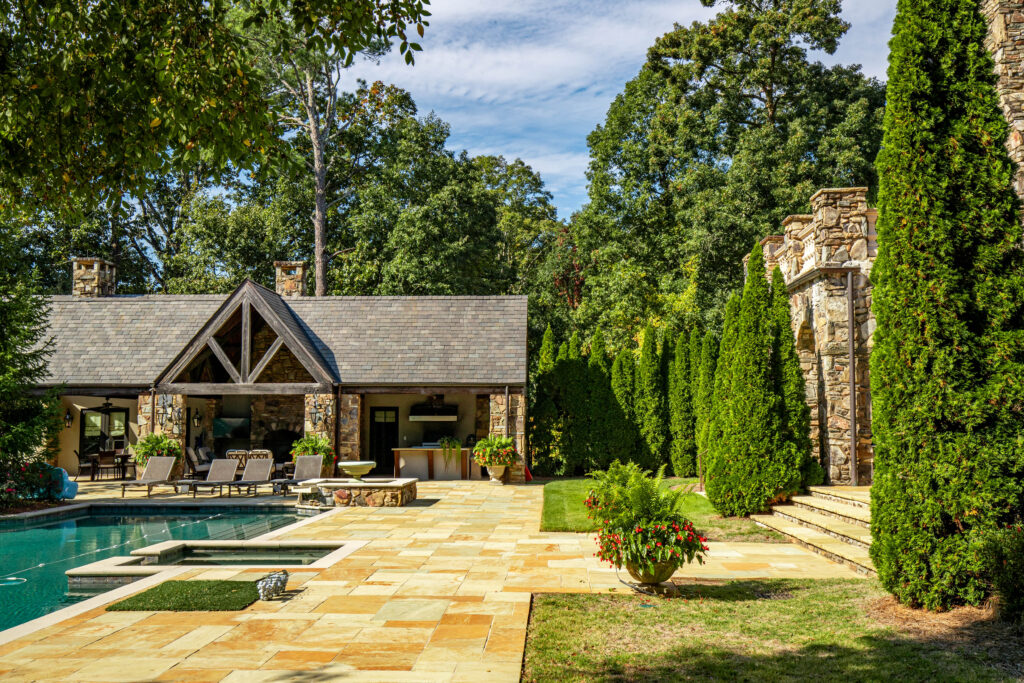
Outdoor living has become an essential extension of the home as an integrated part of daily life, and one that deserves the same level of design intention as any interior space. The most successful landscapes support how you gather, unwind, cook, and connect with family and friends. Layout, flow, and comfort all work together to create a space that invites use from morning to night, weekdays to weekends. Every detail should serve a purpose, enhance the atmosphere, and reinforce the overall rhythm of your home.
Luxurious & Stylish Outdoor Rooms
Start with spatial flow. Outdoor areas function best when each zone has a clear purpose: dining, lounging, gathering, or retreat. Define these zones with natural transitions using changes in material, shifts in elevation, or strategic placement of plantings and structures. When the layout supports how you use the space, the entire environment becomes more intuitive.
Choose furnishings that match the quality and longevity of your interior pieces. Look for deep seating with durable, UV-resistant fabrics, solid dining tables that can anchor a group, and structures like pergolas or shade sails to create definition and relief from the sun. Layer in outdoor textiles such as rugs, cushions, and throw blankets to soften hard surfaces and bring a sense of completion to your design.
Outdoor Entertainment with Elegance
Outdoor entertaining is all about anticipation, the goal is to curate spaces where people want to linger. Built-in speakers set the tone for the occasion, while integrated lighting draws attention to walkways, architectural lines, and key focal points throughout the garden.
To curate your space for entertaining, think beyond the basics. An outdoor projector can turn a quiet patio into an open-air theater. A wood-fired pizza oven becomes a culinary tool and a conversation piece. These upgrades are catalysts for connection by adding energy, personality, and purpose to your landscape design.
Seek a Natural Connection
Even in highly structured designs, organic elements are essential. Plantings, natural stone, and water features create balance and bring a grounded, sensory richness to luxury outdoor living spaces. These components introduce movement, texture, and a sense of place that invites you and your guests to slow down and engage with your surroundings.
Atlanta weather has the perfect conditions for layering in natural beauty to a design. Shaded paths bordered by native azaleas, koi ponds with ornamental grasses, or custom waterfalls with ambient noise all add depth and a sense of peace. These are all excellent choices to enhance your atmosphere, but they also increase property value and support a stronger connection between your home and landscape.
Designing a Sophisticated Outdoor Kitchen and Patio
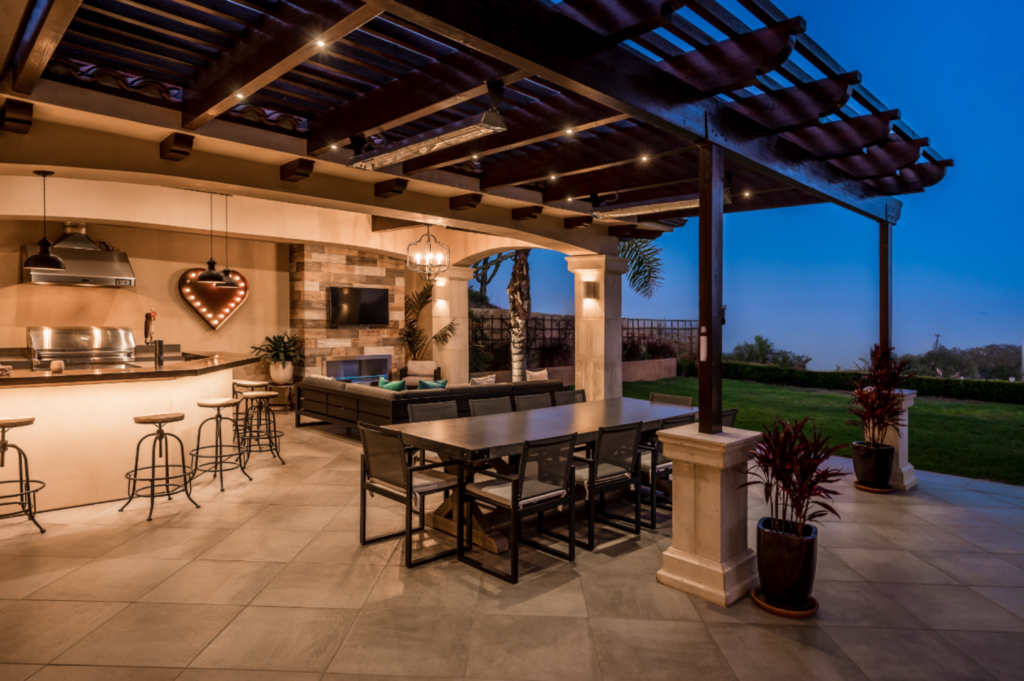
A patio acts as the anchor for your landscape. It supports the flow of movement, defines how zones connect, and creates a natural transition between your home and outdoors. Every material choice, detail, and layout decision plays a role in how the space comes together.
When thoughtfully designed, your patio becomes the starting point for a cohesive and high-functioning outdoor environment. The aim should be to create a patio that anchors your space and ties the architectural and natural elements of your landscape together.
Select Premium Materials
Materials do the heavy lifting in luxury design. Natural stone, large-format porcelain tiles, or hand-crafted brick can all create a refined look but also long-term performance. These options feel solid underfoot and elevate the visual tone of your landscape design.
Travertine is a favorite for patios in the region due to its non-slip surface and cool touch, especially under Atlanta’s summer sun. Granite and slate create bold texture and depth. Granite offers exceptional durability and a clean, structured look that pairs well with contemporary or formal designs. Slate brings rich, layered color variation and a more organic feel, making it a strong choice for landscapes with a natural or transitional aesthetic.
Create Ambiance with Fire & Light
Atmosphere depends on the details that engage the senses. Fire features add visual warmth and invite people to gather, while integrated lighting softens hard edges, and extends usability well into the evening. In cooler months, built-in heaters ensure comfort without disrupting the design. These elements fill space and make for a setting that feels lived-in and ready for any occasion.
Layered lighting is one of the most effective ways to shape the feel of a space, yet it’s often overlooked. A mix of overhead lanterns, low-voltage path lights, and discreet accent fixtures, either tucked into planters or placed up in trees, helps to create depth and draws attention to the right features at the right times. Well-placed uplighting can highlight key architecture or plantings without overwhelming the space. When paired with subtle audio, natural movement like water or fire, and seating that encourages conversation.
Outdoor Kitchen Luxury: Layouts, Appliances & Weatherproofing
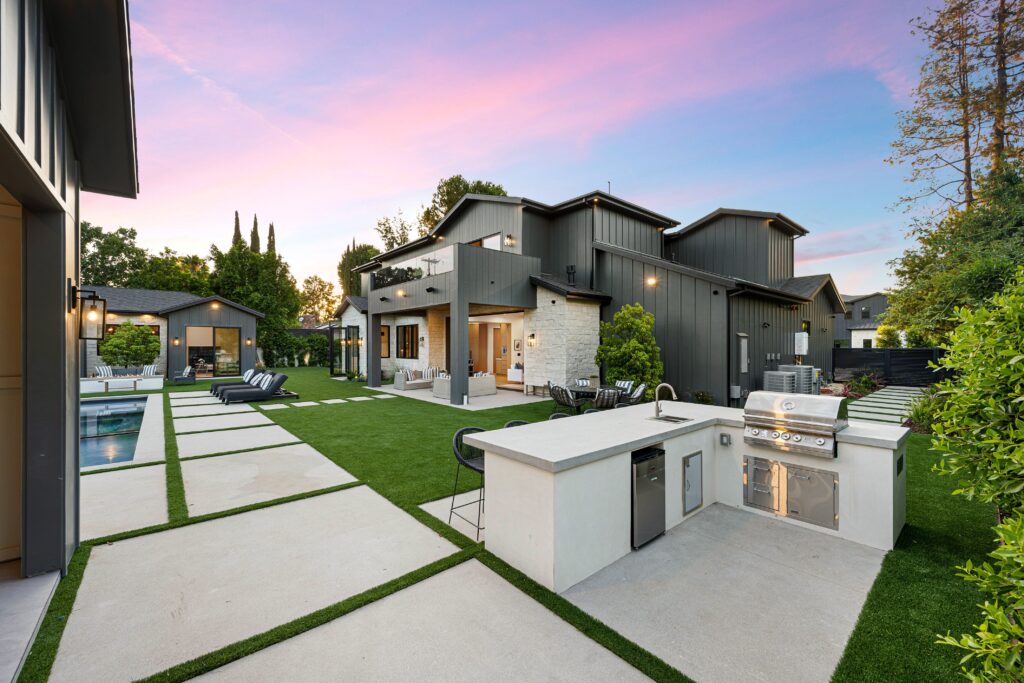
If you want a truly custom space, look beyond the basics. Custom-built pergolas can provide shade, define areas, and create height. Integrated planters let you add green accents without clutter. Built-in seating carves out conversation zones that feel polished and inviting.
Even small upgrades like a vertical herb garden or a custom water feature by the entrance can become signature elements that set your outdoor kitchen apart. These details matter. They show care, elevate everyday moments, and make your space feel designed for you alone.
The Perfect Outdoor Kitchen
When it comes to outdoor kitchen luxury, few additions elevate a home like a fully equipped cooking and dining space under the open sky. Sure, it’s a grill on a patio, but it’s also a fully equipped space that feeds your culinary passions and brings them out into the open air. Entertaining becomes effortless when everything you need is just steps away from the conversation, all while enjoying the fresh Atlanta breeze.
An outdoor kitchen built with care becomes part of your everyday rhythm, not just a warm-weather convenience. With durable materials, a smart layout, and the right amenities, you can prepare meals, host guests, and relax outdoors with ease, no matter the season.
Choose High-End Appliances
Quality appliances are central to any outdoor kitchen luxury setup. Stainless steel grills, weather-rated refrigerators, warming drawers, and outdoor dishwashers all contribute to a seamless cooking experience that functions just as well as your indoor kitchen. Each appliance should support your cooking style and be built to handle Atlanta’s heat, humidity, and seasonal changes.
Look for built-in models with sealed systems and durable finishes designed for long-term outdoor exposure. Matching functionality with durability ensures you can prepare everything from casual meals to full-course gatherings without interruption or compromise.
Designing for Efficiency and Style
An outdoor kitchen should be as efficient as it is refined. The traditional kitchen design with a connecting grill, prep space, and sink is still applicable to your outdoor cooking space. Keeping these zones close but not crowded improves movement and allows multiple people to cook and socialize without crowding.
Cabinetry and countertops should appeal to the overall aesthetic but also withstand the elements. Natural stone, powder-coated metal, or marine-grade composite materials are all reliable options. Choose surfaces that will reflect the style of your home to bring your design together.
Weather-Proofing Your Kitchen Space
Atlanta’s climate demands resilient construction. Materials like sealed concrete, stainless steel, and marine-grade polymers resist fading, warping, and corrosion, even under intense weather swings.
Consider overhead structures such as canopies, pergolas, or full roof extensions to shield the kitchen from direct sun and rain. Proper drainage, UV-resistant finishes, and tight seams protect every detail of the setup, keeping your investment functional and visually strong year-round.
Luxury Landscaping Ideas for Your Atlanta Home

Atlanta’s long growing season and varied terrain give you plenty of room for creativity. With the right layout and plant selection, you can shape a luxury landscape design Atlanta homeowners will appreciate for its visual impact and usability.
Incorporating Water Features
Water brings movement, sound, and serenity into the landscape. A bubbling fountain at the entrance, a reflective pool in a courtyard, or a koi pond surrounded by soft plantings are all timeless luxury landscaping ideas that add elegance and invite interaction.
Strategic placement gives water features purpose and presence. Materials like natural stone, concrete, or ceramic lend a refined, cohesive look that ties into the rest of the landscape. Position each feature to complement sightlines and circulation, allowing it to guide the experience rather than distract from it.
Designing with Water in Mind
Consider how scale and setting work together. A low-profile reflecting pool works well in modern, minimal spaces, while a larger tiered fountain suits a more traditional garden. Let the architecture guide your choices, and use plantings to blend edges and soften transitions.
Maximizing Space with Vertical Gardens
Vertical gardens are ideal for tight spaces and side yards, but they work just as well in expansive landscapes where walls or structures need softening. Modular panels, stacked planters, or living walls give you a way to bring greenery into places where ground space is limited.
These installations add movement and texture while also offering practical benefits like increased privacy or natural cooling.
Enhancing Privacy and Aesthetics
Screens and trellises can provide definition without closing off a space. Use them to section off areas for dining, lounging, or quiet retreat. Climbing plants like jasmine or honeysuckle add softness and seasonal interest, while timber or metal frames offer a clean, architectural edge.
Creative Design Ideas for Vertical Spaces
Use vertical features as an opportunity for expression. Combine wood with steel, mix evergreen climbers with flowering vines, or add subtle lighting to extend their presence into the evening. These surfaces can also double as shelving for planters or decorative pieces, making them both functional and expressive.
Maintenance Tips for Your Luxury Landscape
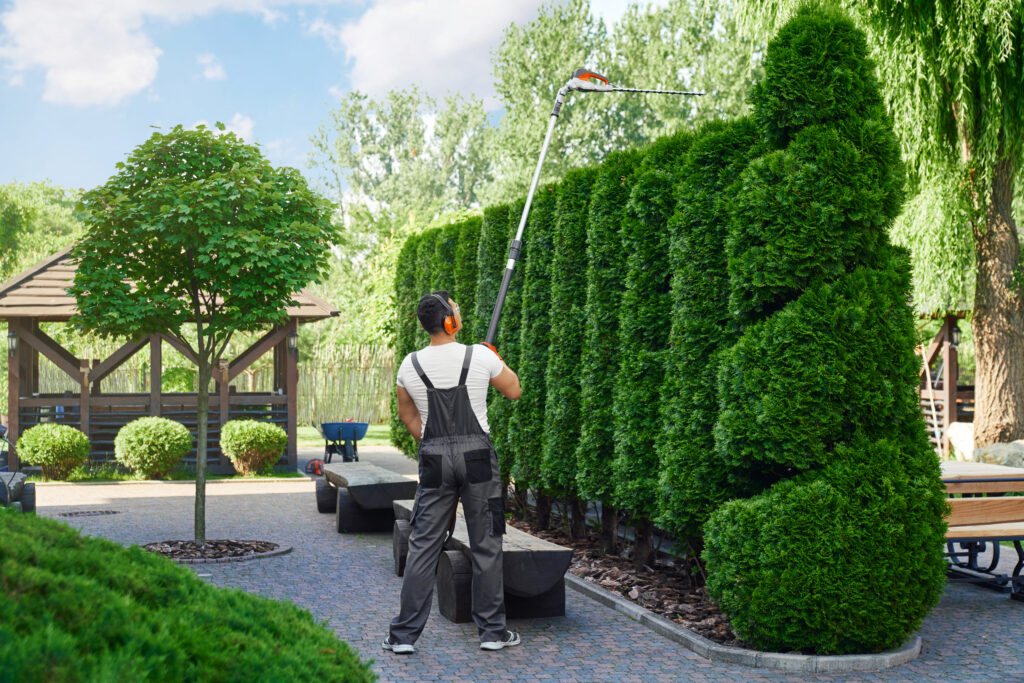
Ongoing care is what keeps a luxury landscape looking and performing at its best. A few consistent practices can extend the life and quality of every plant, material, and structure on your property.
Regular Pruning and Trimming
Routine pruning encourages healthy growth and maintains structure. It’s essential for hedges, flowering shrubs, and ornamental trees that define the form of your garden. Keep plants within their design footprint while promoting airflow and reducing disease risk.
Techniques for Effective Pruning
Use clean, sharp tools and make angled cuts just above buds or branches to direct growth. Time your pruning around bloom cycles to avoid cutting back next season’s flowers. Remove dead wood as soon as you spot it to prevent issues from spreading.
Maintaining Plant Shape and Structure
In structured landscapes, form matters. Without regular shaping, even the best-planned beds and borders can lose definition. Trimming helps maintain visual balance, ensures sightlines remain clear, and keeps focal points intact.
Customizing Irrigation for Plant Needs
Not every part of your landscape needs the same amount of water. Group plants with similar moisture needs into zones, and set your smart irrigation system accordingly. Shade gardens, turf areas, and flower beds each benefit from tailored watering schedules. This approach saves water, reduces waste, and supports overall plant health, making it a valuable part of efficient luxury home maintenance.
Seasonal Strategies for a Landscape That Thrives All Year
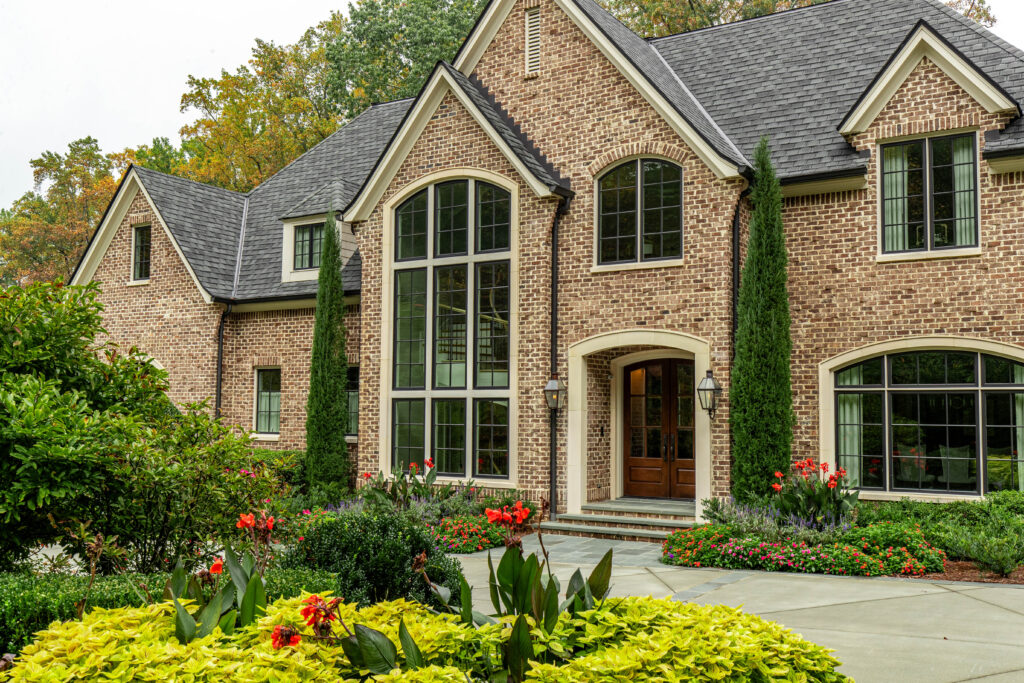
Landscapes in Atlanta and surrounding communities benefit from thoughtful planning across all four seasons. By mixing species, bloom times, and textures, your garden stays vibrant year-round.
Planning for Year-Round Interest
Use seasonal layers to maintain color, structure, and interest. Early spring bulbs bring color after winter, followed by lush summer perennials. Fall foliage and winter evergreens carry the design through colder months. This balance creates continuous movement in the landscape and keeps the visual experience engaging, no matter the season.
Supporting Local Biodiversity
A layered, diverse landscape supports more than just visual appeal. Birds, pollinators, and beneficial insects thrive in gardens that provide shelter and food throughout the year. Choosing native and adapted species strengthens the local ecosystem and adds resilience to your design.
Adapting to Climate Changes
Whether you live in Atlanta or nearby communities, shifting weather patterns call for plants that can tolerate a wide range of conditions. Drought-tolerant perennials, resilient ornamental grasses, and hardy trees reduce long-term maintenance while holding their own through summer heat and winter cold.
Combining smart plant selection with efficient irrigation and well-structured soil gives your landscape the best chance to thrive through every season.
Partnering with a Professional
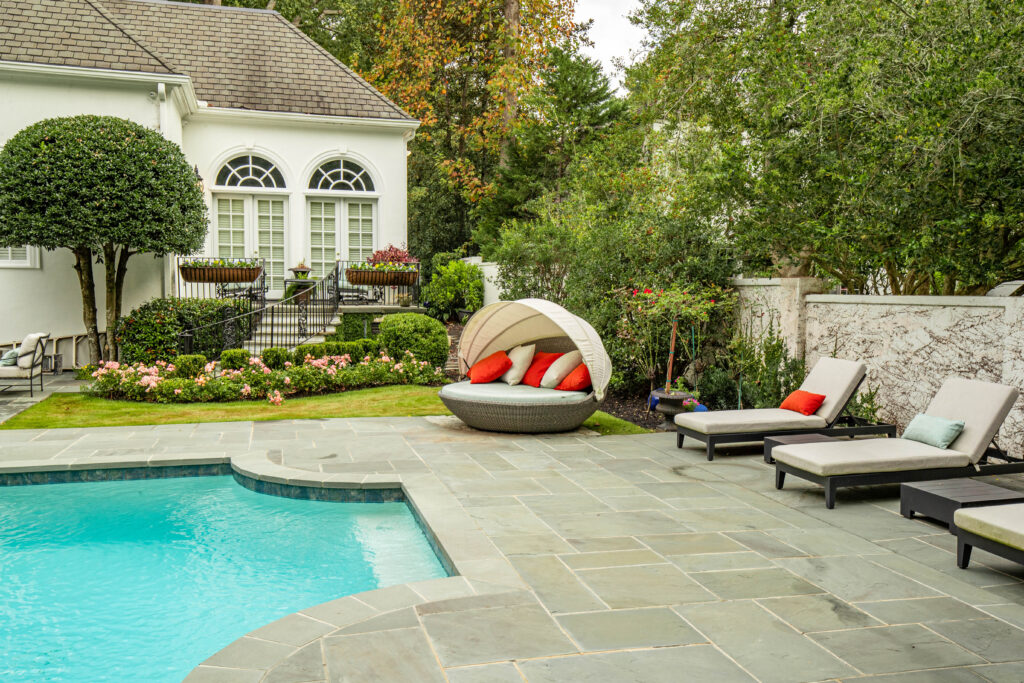
Bringing a landscape to life and keeping it successful long-term requires a combination of experience, vision, and planning. Working with a skilled designer ensures every decision is based on insight, not guesswork.
The Benefits of Professional Guidance
Designers help clarify priorities, streamline choices, and offer proven solutions to common site challenges. They understand how elements work together, from drainage and grading to color and texture. That perspective elevates the final result.
Access to Expertise and Experience
Experienced professionals know what holds up and what doesn’t. They bring technical knowledge about plant behavior, materials, construction methods, and sequencing and that reduces the risk of mistakes or delays.
Innovative Solutions and Creativity
Fresh thinking can unlock potential in your space. A good designer sees possibilities others miss in things like creative lighting schemes and structural features that double as focal points. These additions bring both personality and practicality to the final plan.
Compliance and Project Management
High-end landscapes often involve layered logistics. Permits, inspections, contractor coordination, and timelines need to stay on track. A professional manages these elements while keeping your vision intact and your project moving forward.
Selecting the Right Landscape Designer
Look for someone with local experience, a strong portfolio, and a clear understanding of sustainable practices. Review past projects to see if their design approach aligns with your goals, and make sure their communication style supports collaboration.
Evaluating Experience and Portfolio
Diverse, high-quality work is a strong sign of capability. A thoughtful portfolio shows how a designer approaches scale, materials, and problem-solving across different types of sites and client needs.
Understanding Sustainable Practices
Prioritizing native species, reducing waste, managing water, and designing for long-term performance are hallmarks of sustainable landscape design. Choose someone who treats these principles as essential, not optional.
Communication and Collaboration Open, consistent communication keeps projects running smoothly. The right designer will listen closely, offer clear explanations, and involve you in key decisions from start to finish.
A Living Investment
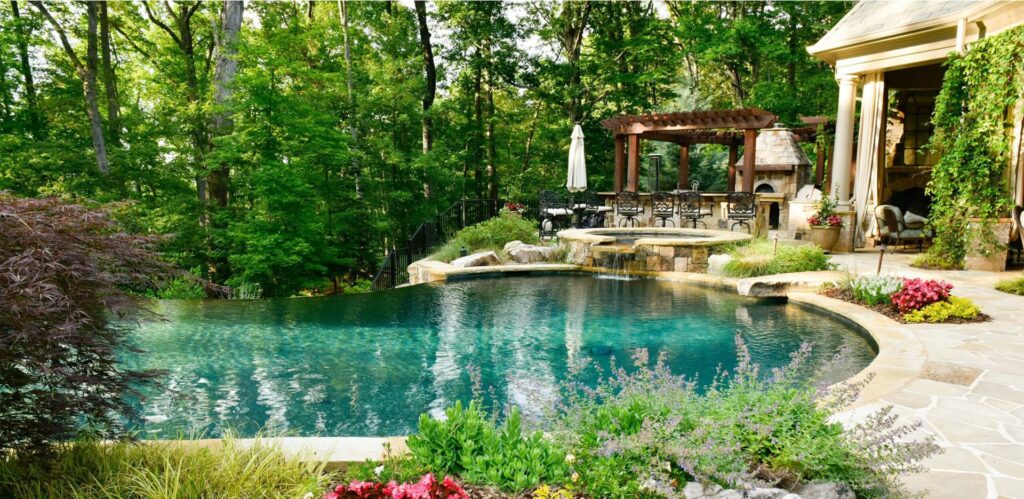
A well-designed landscape shapes how your home feels day to day. It adds rhythm to how you move, where you pause, and how you gather. The materials underfoot, the light overhead, the way space opens or holds you close. It’s these details that change the pace of your home in ways that aren’t always visible, but are always felt.
This guide covered many ideas to help you see what’s possible, but real transformation comes from a design that’s built around your life. One that grows with your routines, reflects your taste, and carries value into every season. When your outdoor space works this well, it stops being a backdrop. It becomes a valuable part of the way you live.
This is where the right partnership matters. Ed Castro Landscape brings decades of award-winning expertise to the table, combining design insight with precise execution. Our team approaches each project with a deep understanding of how your space should function and evolve over time. We build spaces that carry weight: visually, functionally, and emotionally. Not showpieces. Not placeholders. Real environments with presence, made to last and made to be lived in. If your landscape is ready for more than surface-level, this is where it begins.
